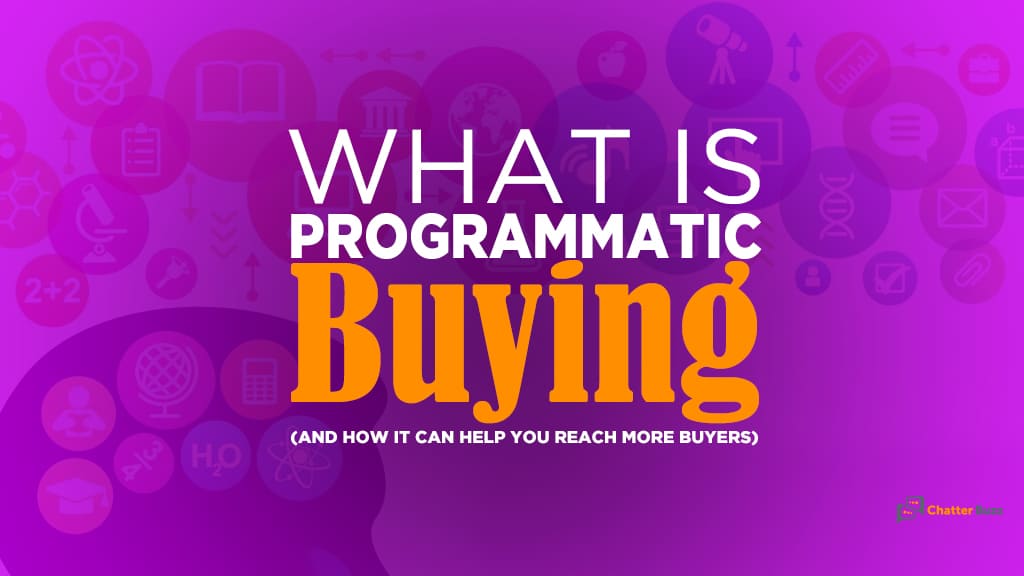What is Programmatic Buying (and How it Can Help you Reach More Buyers)

Fact: There’s a lot of buzz around programmatic buying today.
And for a good reason.
You see, programmatic advertising can deliver a way more targeted reach for your ads, not to mention better ad performance.
And so, it comes as no surprise that, according to eMarketer:
“[…] nearly four of every five US digital display dollars will transact programmatically in 2017, totaling $32.56 billion.”
Incredible, right?
But if the concept of buying ads programmatically seems like a mystery to you, don’t worry.
In this post, I’ll explain what is programmatic buying.
And then, I’ll show you how it can generate more reach and improve your ads targeting, particularly when compared to the traditional media buys.
Intrigued? So, let’s dive in.
What is Programmatic Buying
I admit that the concept of programmatic buying can be quite confusing.
For one, advertising professionals often use the term as a catch-all phrase to describe a wide range of advertising activities.
(And perhaps that would explain the confusion among marketers as to what the term really means).
Others define programmatic buying as intent–based audience targeting, which allows using data to target advertising at the right people at the right time.
Finally, some focus on the role of the automation and machines in the programmatic process.
And you know what, they’re all right!

No, really!
And what’s more, most industry professionals agree that programmatic buying is the future of advertising.
Its rate of adoption proves it quite well. Here, just take a look for yourself:

As eMarketer predicts, by 2019, programmatic advertising spending will rise to 84.0% of the total market. And as they conclude:
“[…] leaving little doubt that buyers and sellers are continuing to invest in automated ad buying.”
But the adoption of programmatic buying is particularly evident on the mobile market.
According to the same source:
“Almost eight in 10 US mobile digital display ads are purchased programmatically—a portion that will rise to 85.2% by 2019.” (source)
So, let’s clarify what is programmatic buying then.
To explain it in the simplest terms – the term refers to using technology and big data to automate and optimize the ad-buying process in real time.
Here, let me illustrate this with an example.
Think of any Adwords campaigns you may be running already.
As you know, Google uses various algorithms to determine how to serve ads to viewers to ensure they’re always relevant. Here’s a quick run through the process (courtesy of Hubspot):

But as an advertiser, you can also use the search engine’s platform to adjust your bid in real time to ensure the highest ad performance.
(And the key phrase here is real time.)
Programmatic buying is based on a similar concept, although it takes it one step further.
When optimizing advertising programmatically, you get algorithms and software to sift through vast amounts of big data, from consumer behavior to ad impressions and much more.
And then, use it to adjust budgets automatically, define audience targeting and work on other aspects of campaigns, often in real time.
But how is programmatic any better?
Fact: In the last couple of years, marketers and advertisers went berserk for programmatic.
The adoption rate data I showed you earlier proves it well.
But is programmatic really so much better than the traditional approach?
Oh absolutely!
Here, let me show you.
In the traditional media buying, if an advertiser wanted to serve ads on a particular medium (let’s say, a website, for example), they had to contact a publisher (in this case, the website owner) and purchase the ad space from them.
The process then would involve anything from purchase orders, and plenty of other paperwork defining the ads to run, on what schedule, and for how long.
And that’s really just the tip of the iceberg.

As Peter Naylor, former EVP at NBCUniversal points:
“Sellers and buyers used to spend all day faxing change orders on deals they were actively optimizing for performance or delivery.”
As a result, almost every aspect of campaign management was a challenge.
Marketers couldn’t get a full picture of how their campaigns perform, since data would be scattered across various publishers.
They also couldn’t respond and amend strategies in real time.
Programmatic buying overcomes all those, along with many other challenges.
For one, it allows you to automate your online advertising activities. But also, use and process all the data to vastly improve your ad targeting.
As Jay Sears states over at Adweek (note, the emphasis in bold is mine):
“It allows you to [place ads] with individual pieces of media as well as individual pieces of data. It makes advertising smarter.”
How? For example, by allowing the use of demand-side platforms (DSP) to automate the online advertising purchase from multiple publishers in one single space.
Here’s how the process looks in practice:

DSPs connect to an ad exchange networks, featuring thousands of publishers that offer ad space, and allow marketers to bid and place ads on them from a single interface.
What’s more, bids (or prices for those ad impressions) are calculated in real-time by the system, as a user lands on a relevant web page or app.
Now, compare that with the traditional model we discussed earlier on. One that included human interaction, and exchanging of countless documents for each publisher….
A staggering difference, right?
How Programmatic Buying Helps Boost Advertising ROI
Of course, an increased efficiency in the ad buying process is not the only benefit the programmatic advertising delivers.
More importantly, it helps increase the effectiveness of your campaigns.
Here’s how.
#1. Much wider reach
A huge benefit of using DSPs is that they provide you with the opportunity to bid on ads in real-time, and serve them on a large number of other platforms, as well as track and optimize your campaigns.
All from a single interface.
As a result, you can be much more efficient in how you allocate your advertising dollar, with algorithms adjusting your campaigns to deliver the greatest ROI.
#2. Incredible audience targeting
This is where DSPs truly shine. You see, unlike display networks, DSP platforms allow you to target the audience an incredibly high level.
Here are just some of the targeting options you can typically avail of:
- Geo-targeting
- Targeting by demographics
- Keywords
- Contextual targeting
- Targeting specific devices
And much more.
By combining various targeting options, you can truly ensure that your ads reach the exact audience you want to attract to your services or products.
Conclusion
Programmatic buying is on every advertiser’s lips today, and for a reason.
After all, this new way of managing advertising campaigns delivers a more targeted reach, as well as higher ad performance.
And hopefully, after reading this post, you have a good idea about it and know why it might be worth to buy you next ads programmatically.
Do you need someone to help you achieve your growth goals - then let us help you crush them? Let's chat!
Error: Contact form not found.









